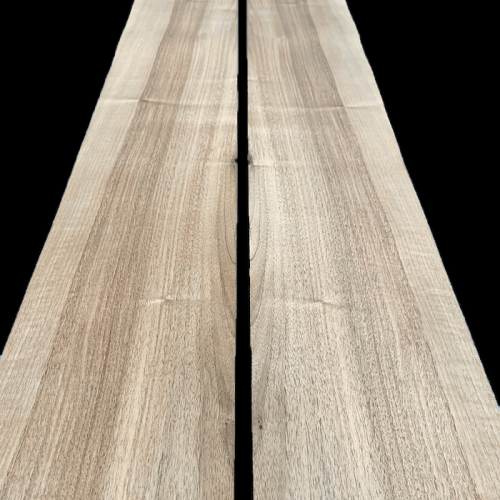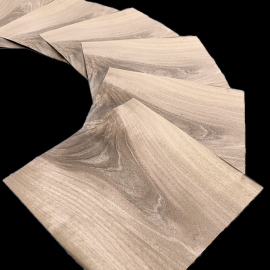
Harlequin Walnut Veneers 200 x 23 cm
Harlequin Walnut Veneers 200 x 23 cm
Genuine wood sliced-veneer sheets, in sequence.
Length: 200 cm.
Width: 23 cm.
Thickness: 0.6 mm.
Sold by the sheet.
These photos are taken from the veneer sheets you will receive.
Harlequin Walnut Veneers 200 x 23 cm
Genuine wood sliced-veneer sheets, in sequence.
Dimensions:
Length: 200 cm.
Width: 23 cm.
Thickness: 0.6 mm.
Measurement scaling:
The width is rounded to the covered centimeter. For example, 15.8 cm is given 15 cm.
The length is rounded to 5 centimeters. For example, 257 cm is given 255 cm.
Pictures:
These photos are taken from the veneer sheets you will receive.
While we strive to capture the color as accurately as possible, please note that the color may vary slightly from the photo. The screen on which the photos are viewed can also affect their appearance.
What is Harlequin Walnut?
The Harlequin Walnut owes its name to its unique color: a dark brown heartwood contrasting with a blond sapwood.
Although these walnut veneers come from France, Harlequin Walnut was originally from Italy. Indeed, the Italian veneer makers of the 19th century named this multicolored wood after the famous character of the Commedia dell'arte, "Arlecchino."
What are the common Names for this wood?
Harlequin Walnut is a commercial name for French walnut or European walnut.
What is the botanical name for this wood?
Juglans Regia.
According to Pliny the Elder, "Juglans" comes from "Jovis Glans," meaning "Jupiter's acorn."
Where can we find European walnuts in nature?
European walnuts (Juglans regia) are native to southeastern Europe and western Asia. This region includes countries like:
Europe: Greece, Italy, Spain, France, Bulgaria, Romania, Serbia, Croatia
Asia: Turkey, Armenia, Georgia, Azerbaijan, Iran
These trees have been cultivated throughout Europe for centuries and are now found in other parts of the world.
How to Recognize European Walnut Wood?
European walnut is a rather turbulent wood with a pronounced natural character.
Unlike American walnut, which is dark with purplish hues, French walnut has a lighter brown base color. With the patina of time and wax, its color will take on a superb depth of shine.
Several specialties are particularly sought, such as swirl, a root section of the trunk offering a vibrant grain pattern, or burl, a growth of hundreds of small pin-knots.
What are the mechanical properties of European Walnut?
Weight: 640 kg/m³, average weight at 10-12% moisture content.
Janka hardness: 5410 Newton, for comparison: Oak is 4980 N and Poplar is 1650 N.
Elasticity: 10.81 Gigapascals; for comparison, American maple is 12.62 GPa, and Poplar is 9.75 GPa.
Tensile strength: 111 Megapascals; for comparison, US maple is 109 MPa, and Oak is 47.3 MPa.
What are the uses of walnut veneers?
This wood is appreciated in the manufacture of furniture, in decoration, in the dashboards of luxury cars, in guitar making, and in the restoration of old radios.
What is veneer?
Veneers are thin sheets of wood obtained by slicing or peeling.
Their surface has the appearance of planed wood without any finish or treatment. They are neither glued nor backed with any other material. This means that both faces of the sheets can be used.
Veneers are mainly used to cover less aesthetic substrates such as plywood or particleboard to make furniture or wall panels.
Wood veneers are also used to create decorative objects such as lamps, jewelry, bookmarks, and more.
By assembling several sheets of veneer on top of each other, it is possible to manufacture objects requiring high mechanical resistance, such as skis, bicycle frames, or musical instruments.
The applications of veneer are as varied as they are multiple.
Since veneers are genuine wood, all wood finishing products, whether varnish, stain, or oil, are suitable. The choice of finish will depend on your personal preferences and the final use of the object.
The veneer offered here is a sliced sheet of uniform thickness, but the thickness might differ from one species to another. The standard thickness is around 0.6 mm.
Although the edges of the veneers have been cut roughly straight, the cut is not perfectly parallel. Some veneers may retain the natural taper of the tree, being slightly wider at the foot than at the top.
Some veneers may have a trace of a waney edge (an edge following the tree's natural shape) on the sides. In this case, the dimensions indicated correspond to the minimum width of the veneer, as specified in the "Dimensions" paragraph.
How to use veneers?
How to cut the veneers?
Veneers can be easily cut with a utility knife.
For straight cuts, the best results are obtained with a veneer saw.
Use a fretsaw, scalpel, or veneer knife for curved cuts.
Always allow for a slightly larger veneer sheet than your intended surface. This will allow you to adjust the size after gluing for a clean finish.
A flush trimmer can also be used to trim the veneer after gluing.
When cutting with a utility knife or veneer knife, it is best to cut with the grain of the wood. To check this, run your finger along the edge of the sheet. The direction that feels smoothest is the ideal direction for cutting.
What is veneer splicing?
As the veneers have the width that nature gave us, you might need to cover an area wider than the veneers available.
Therefore, you need to splice the veneers by gluing or fixing them side by side with tape to obtain the desired width.
Trim the veneer's edges with a straight and smooth cut to realize good jointing.
Stick the veneers with tape (the blue one is a good choice.)
Usually, the veneers are spliced side by side, but to obtain a longer length, they can be done foot by foot.
The splicing must be done before gluing the veneers on the substrate.
What Glue to Use for Veneering?
Several types of gluing are possible.
Vinylic glue (PVA or PVB) is well adapted to porous substrates such as plywood, particle board, or MDF. The veneers must be pressed with clamps over the entire surface at once.
Note: A technique using vinylic glue and an iron can also be used to glue veneers, but we strongly recommend choosing this technique only if other gluing solutions are impossible.
- Neoprene glue is applied to all surfaces, especially non-porous surfaces, using two coats of glue and marouflage.
- Animal glue, such as hide, sinew, or bone glue, are pellets that must be cooked in a double boiler and used hot.
How to Sand Veneers?
Veneers and all our products are genuine wood and can be sanded according to thickness.
Please do not use a belt sander, regardless of the thickness of the veneer, as this could pierce it.
With a 0.6 mm veneer, lightly sand with 120 grit and then finish with 180 or 240 grit. With an orbital sander, 180 grit is already sufficient for most applications.
How to Finish a Veneer Realization?
All finishing products generally used for wood are suitable for finishing our products. For example, you can use a varnish, wax, paint, or oil.
However, ensure that the product you want to use is compatible with the final use of your creation.
More information:
Please look at our TUTORIALS; you might find some valuable tips.
Please contact us by email or phone for any additional information.
Data sheet
- Species
- Walnut
- Thickness group
- Standard
- Grade
- Quarter-cut
You might also like
 English
English







